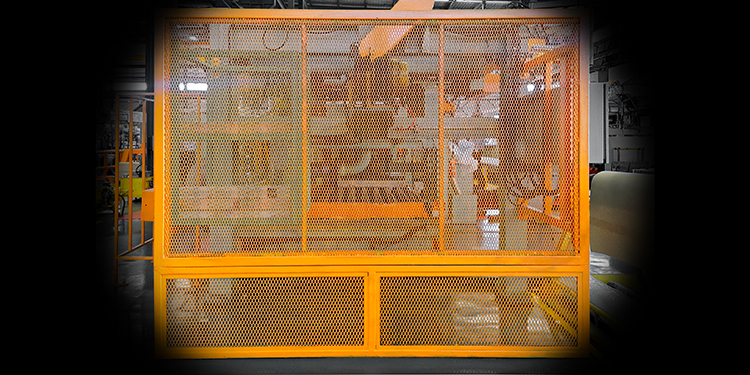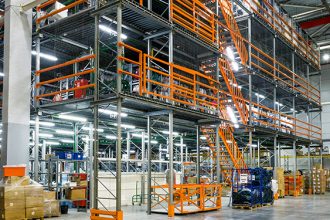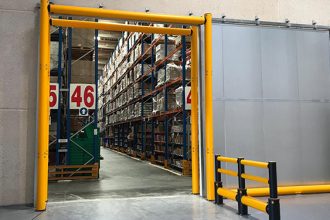Key Components Of A Risk Assessment For Protective Industrial Guarding

Protecting and safeguarding the health and well-being of personnel working within a warehouse, distribution center, or manufacturing facility is of paramount importance. Many operations strive to achieve this through ongoing safety training, as well as by installing protective industrial guarding systems that provide a physical barrier between staffers and hazardous areas or equipment.
To determine which type of guarding material should be used around a potential danger — as well as how the barrier should be constructed — the facility and equipment owner must first perform a risk assessment. This multi-step process involves identifying the hazards associated with the system or process, determining who might be at risk of harm from the machinery or equipment, evaluating the potential dangers, deciding how to best prevent them, and implementing the appropriate guarding type that will best mitigate those hazards.
There are a variety of standards that cover risk assessments. ANSI B11.0: Safety of Machinery, applies to new, existing, modified, or rebuilt power-driven machines. ISO 12100: Safety of Machinery, General Principles for Design, Risk Assessment and Risk Reduction specifies terminology, principles, and a methodology for achieving safety in machinery design based on knowledge and experience of the use, incidents, accidents, and risks associated with machinery. The RIA TR 15.306: Task-based Risk Assessment Methodology is a supplement to ANSI/RIA R15.06: American National Standard for Industrial Robots and Robot Systems (Safety Requirements) that describes a robotic risk assessment process. In general, risk assessments performed for a specific piece of equipment or machinery include a fairly universal series of steps, outlined as follows:
Step 1: Assemble a Team. Members represent the different types of workers whose job roles will require them to interact with the piece of equipment being assessed in order to perform specific tasks.
Step 2: Identify Tasks and Hazards. It is critical to know who will interface with the machinery and what they will be doing (operators using the equipment; maintenance technicians servicing and repairing it; janitors dusting the housing or sweeping around it; material handlers driving forklifts in proximity to it; etc.). This information helps inform the scope of what the assessment will include. The scope may only cover risks associated with the equipment during normal operating conditions or during changeovers, preventive maintenance tasks, unscheduled downtime for repairs, the immediate workspace and/or traffic area around the machinery, or other limits.
Step 3: Assess Initial Risk. When considering the risks surrounding a piece of equipment or machinery, it is important to ignore any guarding that is already in place. The guarding may or may not provide adequate protection against some (or all) risks, but at this stage of the assessment its presence is irrelevant. Instead, considering the personnel roles and tasks to be performed, determine the types of hazards that could cause injury.
Step 4: Assign Ratings to Risks. After identifying potential risks, rate them in terms of severity of harm (small cut versus amputation) and the probability of occurrence (highly likely to highly unlikely). There are a variety of different scoring systems available — including those included in ANSI B11.0 and ISO 12100 — to help determine the appropriate rating of the risk level.
Step 5: Implement Measures to Reduce, Mitigate, or Eliminate the Hazard. A hierarchy of risk reduction measures — from most preferred to least preferred — exists. At the top of the list is what is known as “Inherently Safe by Design” measures that eliminate the need for a risky task to be performed by modifying the design of the equipment. For example, if maintenance personnel must come into direct contact with a hazard in order to apply lubrication, perhaps there is a way to design a different lubrication access point that is external to the machine safeguarding. This eliminates the need for maintenance technicians to directly interface with the machine. A second measure would be to add engineering controls, such as protective guarding (or, if guarding is already present, keep or enhance it). A third measure would be applying administrative controls, such as additional warning lights, signs, labels, beacons, strobes, and so on to alert personnel to the risk.
Step 6: Reevaluate the Risk. Once the measure (or measures) has been implemented to reduce or eliminate the risk posed by a certain hazard, the assessment process should be repeated to determine if the measure has adequately minimized its probability or severity rating. This process repeats until the team assembled in Step 1 is satisfied that the risk no longer exists or has been reduced to an acceptable level as defined by the ANSI B11.0 or ISO 12100 standards.
Step 7: Validate the Solution(s). Once an acceptable level of risk has been reached, the applied solution(s) must be tested and validated per the standards. Testing the risk reduction measure will ensure that it effectively accomplishes its anticipated functionality. The results of the testing should be documented, marking the conclusion of the risk assessment.
In addition to these seven steps, risk assessments also need to take into consideration any additional safety standards that apply to the specific piece of equipment or machinery in question. Standards are categorized into three types:
- Type-A standards (basis safety standards) give basic concepts, principles for design, and general ‘foundational’ aspects that can be applied broadly across different types of machinery.
- Type-B standards (generic safety standards) deal with one or more safety aspects or one or more types of risk reduction measure that can be used/applied across a wide range of machinery.
- Type-C standards (machine safety standards) deal with detailed safety requirements for a particular machine or group of machines.
For example, a risk assessment to determine the type of protective industrial guarding to be utilized around an electrical panel or cabinet would be subject to all three standard types — specifically NFPA 70E: Standard for Electrical Safety in the Workplace, NFPA 79: Electrical Standard for Industrial Machinery, and Occupational Safety and Health Administration’s OSHA 1910 Subpart S section 1910.303(g)(1). Each includes details about minimum safe distances for protective guarding surrounding the equipment.
Step 8: Document and Train. Documentation and training are a critical aspect of the risk assessment process. ANSI B11.0 calls for the outcome of the risk assessment to be documented, including details about the procedure followed, hazards identified, and risk reduction measures used. Retain the documentation for the life of the machine. Likewise, all personnel should be trained in safe working procedures with the equipment, and only qualified personnel should perform those tasks.
Need more guidance for, or assistance in, performing a risk assessment for machinery and equipment within your operation? The members of the Protective Guarding Manufacturers Association (ProGMA) are available to help end users, installers, integrators, machine users and more to understand how to mitigate the potential risks within their facilities.



